Growing up, we’ve been told stories about dragons. But in most of the fairytale stories we’ve heard, dragons were evil large-winged creatures that breathed fire and destroyed the lives of innocent people. In China, the opposite is true. To the Chinese, the dragon is a sacred mythical creature, held in very high esteem. They look at dragons as guardians sent down by the heavens to aid and protect mankind.
As such, dragons are a large symbol and identity of the Chinese people. It is incorporated in almost all aspects of China, from the architecture to the cuisine and in every celebration through activities like dragon boat festival and the dragon dance.
The dragon dance is perhaps the most revered in China. It is performed in many Chinese festivals and is considered a major symbol of Chinese culture. Understanding the importance of the dragon dance requires you to first understand its origin and meaning. In this post we will cover that and as a bonus, how the dance is performed, from costume to dance steps.
what is the Chinese dragon dance?
The Chinese dragon dance is a traditional performance that is an integral part of Chinese culture and celebrations. It involves a vibrant and colorful dragon made of fabric, paper, and bamboo that is operated by a team of skilled dancers. The dragon is often very long and can be up to dozens of meters in length, requiring many dancers to manipulate its movements.
The dragon dance is commonly performed during Chinese New Year, Lantern Festival, and other festive occasions or celebrations. It is believed to bring good luck, prosperity, and blessings to the community and those who witness the performance.
The dragon dance originated from ancient people’s worship of dragons. During joyful and festive occasions, people would perform dragon dances. The tradition of dragon dancing begins during the Chinese New Year and continues throughout various celebrations, such as the “Dragon Raising its Head” in the second lunar month and dragon dances during the Dragon Boat Festival.
During the dragon dance, the dragon follows a ball or a pearl, performing a variety of movements and actions, including twisting, waving, arching, kneeling, jumping, and shaking. This dynamic display showcases the dragon’s agility and power.
The dragon dance serves as a cultural folk tradition across China, where people use this form of dance to pray for safety and a bountiful harvest. The dragon’s movements are believed to bring good luck and blessings to the community. It has become a cherished part of the Chinese cultural heritage, symbolizing unity, prosperity, and the hopes for a prosperous future.
how to say dragon dance in Chinese?
The dragon dance referred to as “龙舞” (lóng wǔ) or “龙灯” (lóng dēng) in Chinese, it is meaning dragon dance or dragon lantern dance,is a time-honored cultural tradition. This captivating performance involves a group of skilled performers manipulating long poles to gracefully move a dragon prop. The dragon, a symbol of strength, auspiciousness, and good fortune in Chinese mythology, comes to life as it gracefully undulates and weaves through the air. The dance is commonly featured in various celebratory events and festivals, especially during the Chinese New Year and other joyous occasions. It is believed that the vibrant and rhythmic dance of the dragon brings blessings of prosperity, luck, and harmony to the community. The colorful spectacle captivates onlookers, fostering a sense of unity and joy among the participants and the spectators alike, making it an inseparable part of China’s cultural heritage.
what type of dance is the dragon dance?
Chinese people are a creative nation. Dragon dance performances are widely seen across various regions, with numerous variations and distinct characteristics. Common types of dragon dances include the Fire Dragon, Grass Dragon, Mao Dragon (from Shiqian, Guizhou), People Dragon, Cloth Dragon, Paper Dragon, Flower Dragon, Basket Dragon, Segment Dragon, Candle Dragon, Drunken Dragon, Bamboo Leaf Dragon, Lotus Dragon, Bench Dragon, Pole Dragon, Rolling Ground Dragon, Seven Stars Dragon, Big Head Dragon, Luminescent Dragon, Firework Dragon, and many others, totaling close to a hundred. Dragon lanterns typically have 7, 9, or 13 sections. Since ancient times, dragon dance activities have remained popular and have been passed down from generation to generation.
Now, let’s translate the specific types of dragon dances mentioned in the text:
High Pole Dragon Dance
Leizhou High Pole Dragon Dance
Leizhou High Pole Dragon Dance is a traditional festive dance of the Leizhou region in Guangdong, China, where the ancestors used it to pray for good weather and national prosperity. The performance is typically done by young men who wear traditional costumes, including open-fronted shirts and baggy pants, and each dancer stands on tall poles while carrying a dragon prop on their head. The dance revolves around themes of dragons meeting and establishing friendship while soaring in the sky. The dance includes a series of challenging movements such as intertwining, swinging, and teasing the dragon. The dragon props are made of fabric, bamboo, and paper, with vivid and unique designs. This tradition continues to be performed during the Lantern Festival and Mid-Autumn Festival in the rural and urban areas of Leizhou in Guangdong’s Zhanjiang city.
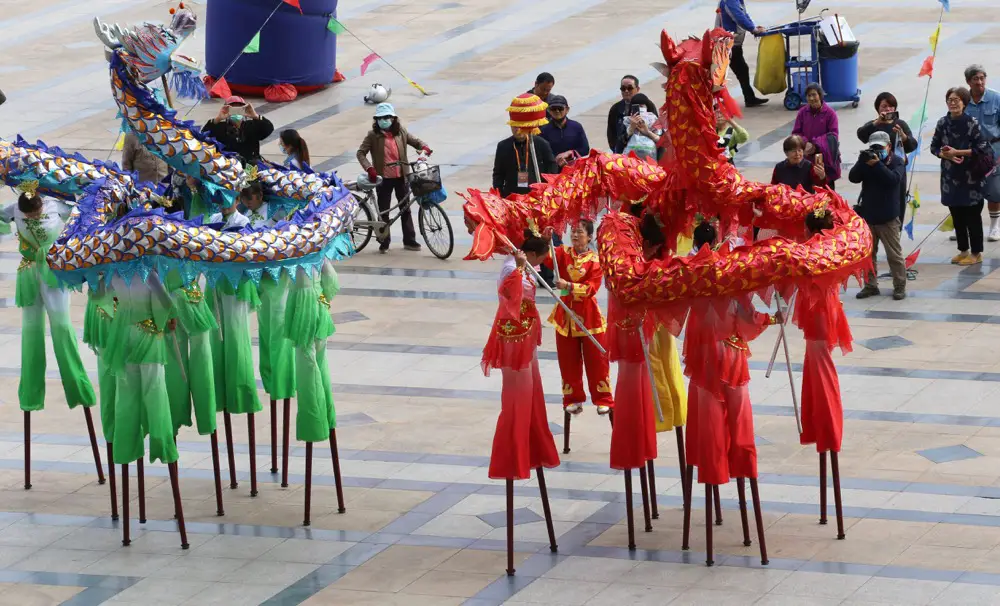
Mianyang High Pole Dragon Lantern
Mianyang High Pole Dragon Lantern is a popular folk dance form in Xiantao City, Hubei Province. Local artists combine the use of high poles with dragon lanterns in a unique and skillful way that impresses spectators. Compared to regular dragon lanterns with thirteen to fifteen sections, Mianyang High Pole Dragon Lantern has only nine sections, but the intervals between the sections are longer, making it suitable for performing on stilts (which can reach up to 2 meters in height) while dancing with the dragon lantern. The dragon comes in two colors, yellow and red, unlike regular dragon lanterns that are not limited in color. The performers dressing up as famous characters from traditional Chinese drama, with one playing the leading female role, another the young male hero, and the rest playing the dragon’s body sections.
Grass Broom Dragon
Grass Broom Dragon (also known as Grass Rake Dragon or Grass Hoe Dragon) is a form of intangible cultural heritage popular in the Zigong area of Sichuan Province. Its origins can be traced back to the Tang Dynasty and has a history of over 1,400 years. According to legend, during the rice growth period in the fields in May or June of the lunar calendar, pests and diseases were prevalent, and farmers performed the Grass Broom Dragon dance to drive away the pests and pray for good weather. Nowadays, this activity has evolved into a folk, recreational, and fitness event. In 2009, the folk art of the Grass Broom Dragon in Wubao was successfully declared as Sichuan Province’s Intangible Cultural Heritage. The Grass Broom Dragon is made using straw as the main material, skillfully crafted by artisans. The proportions of the dragon’s head, body, back, and tail are well balanced, giving it a rustic and artistic appearance, evoking a sense of ancient and lively charm.
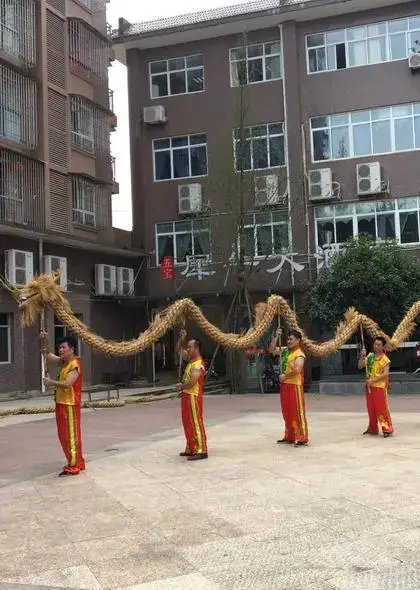
Cloth Dragon
The Cloth Dragon is made with bamboo strips as its skeleton, covered with cloth, and connected with hemp ropes. The cloth is painted with colorful dragon scales. Inside the dragon’s body, there are candle holders where candles can be placed, allowing the dragon to emit light and glow during nighttime performances, giving the appearance of a real dragon.
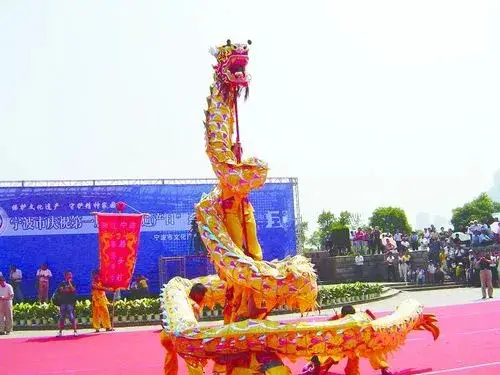
Dragon Head Dance
The Dragon Head Dance is a ritual performed during ancestral worship activities in Fujian. It forms part of the ceremonial procession, which includes symbols such as the sun, moon, and stars. The dragon head is carved from wood and painted with colors, presenting a solemn and ancient appearance. During the ancestral worship, the performer holding the dragon head follows the rhythm of the drums, performing various movements, such as advancing, retreating, dancing, stopping, jumping, or crouching, all following a specific pattern. The Dragon Head Dance depicts the birth and growth of the “Nine Dragons” and includes routines such as “The Birth of the Nine Dragons,” “The East Sea Marriage,” “Clouds and Rain,” “Seeking a Partner in the Deep Pool,” and “The Nine Dragons Returning to Their Positions.”
Ma Dragon Dance
The Ma Dragon Dance is practiced in the Longxi area of Sichuan, and it is a form of sports activity during ancestral worship. The performers wear a string of copper bells around their waists. The female dancers hold a colored flower stick decorated with colored balls and ribbons, while the male dancers carry a colored stick with a beautifully crafted dragon head on one end and a long hemp beard of over 7 meters on the other end, representing the dragon’s body. Accompanied by the sound of gongs and drums, the dragon’s head rises and falls, and the Ma Dragon dances and flies while the flower stick spins and interacts with the dragon. The sound of the dragon’s body swinging, combined with the bells at the waist and the iron rings on the stick, creates a unique and captivating atmosphere.
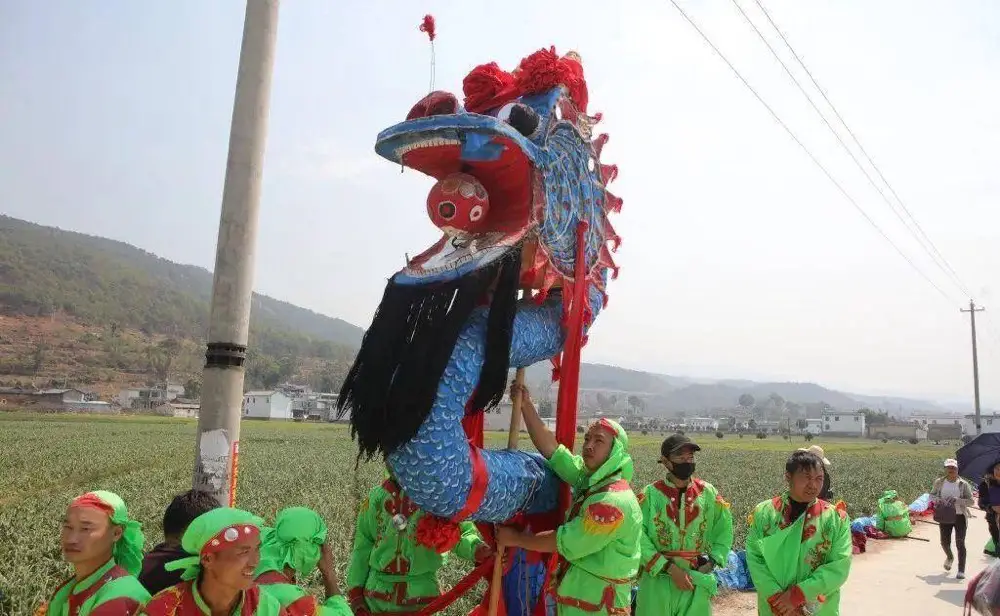
Grass Dragon Dance
The Grass Dragon Dance is unique to Tiaoshun Island, Chikan District, Zhanjiang City, Guangdong Province. It was popular from the mid-Ming Dynasty to the mid-Qing Dynasty. Every year during the first month of the lunar calendar, the Grass Dragon Dance is an essential activity, along with the Net Dragon Dance. For the Grass Dragon Dance, around 20 strong young men are selected to perform. The Grass Dragon is made by weaving straw into ropes and winding them around the bamboo frame for the dragon head and tail. The body of the dragon is made by weaving straw ropes in a scale pattern along the fishing net, representing the dragon’s body. Through careful reforms and innovations, the Tiaoshun Grass Dragon Dance has developed various routines, including “Two Dragons Competing for the Pearl,” “Two Dragons Piercing the Clouds,” “Twisting the Dragon Tail,” and “Two Dragons Twisting Around Each Other,” showcasing the dragon’s powerful spirit and winning the admiration of the masses.
Xianghuo Dragon
The Xianghuo Dragon has a long history, as documented in the historical records of Rucheng County, Hunan. It is prevalent in the Nanxiang area and is often performed during the Lantern Festival. The performance includes two dragons (the mother dragon and the son dragon) and two lions (the mother lion and the son lion) accompanying the dance. One lion leads the way in front of the dragon, while the other follows behind the dragon’s tail.
The entire body of the Xianghuo Dragon is made from bamboo and straw. The “mother dragon” typically consists of seven sections, and the “son dragon” has around five sections, with both dragons adorned with special “Luohan incense” (approximately 0.53 meters long) inserted throughout their bodies. As the night falls, signaled by three cannon shots, drums, woodwind instruments, fireworks, and gongs all resound together. People light up all the incense on the dragon’s body with torches and carry the dragon in a parade. The scene is truly spectacular.
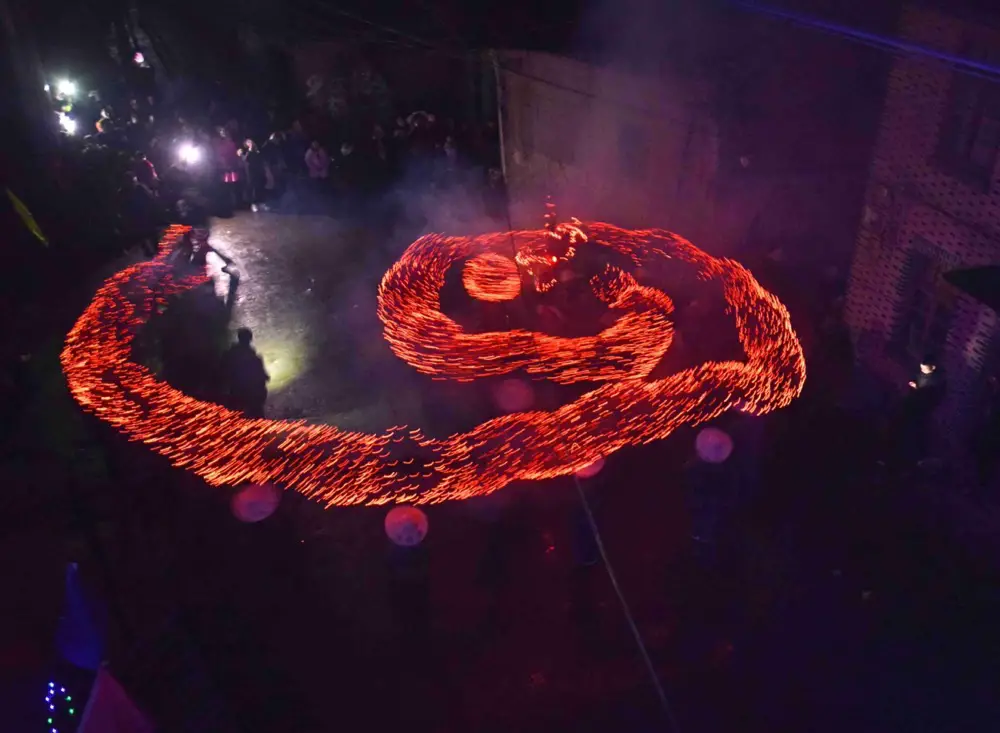
The Fire Dragon Dance is a traditional folk performance that includes various movements such as rolling, spouting water, submerging into the sea, jumping, swallowing, and sleeping. The actions of “submerging into the sea” and “swallowing” are particularly challenging in terms of skill. The performance involves a leading dragon and two following lions. Besides performing rolling and jumping actions, the lions also act as escorts to the dragon.
The Fire Dragon Dance is often held during insect disasters. The dragon’s body is adorned with lit incense, creating a shimmering dragon in the night sky. Fireflies chase after the dragon, attracted by the flickering lights. The Fire Dragon dances through the streets and reaches the fields, where insects gather in pursuit of the incense. Suddenly, the dragon team stops by a water pond, and they forcefully submerge the grass dragon, head to tail, deep into the water. This action drowns both the dragon and the swarm of insects. The Fire Dragon Dance serves a practical purpose in pest control, giving it higher practical value compared to other forms of dragon dances.
Blinds Dragon Dance
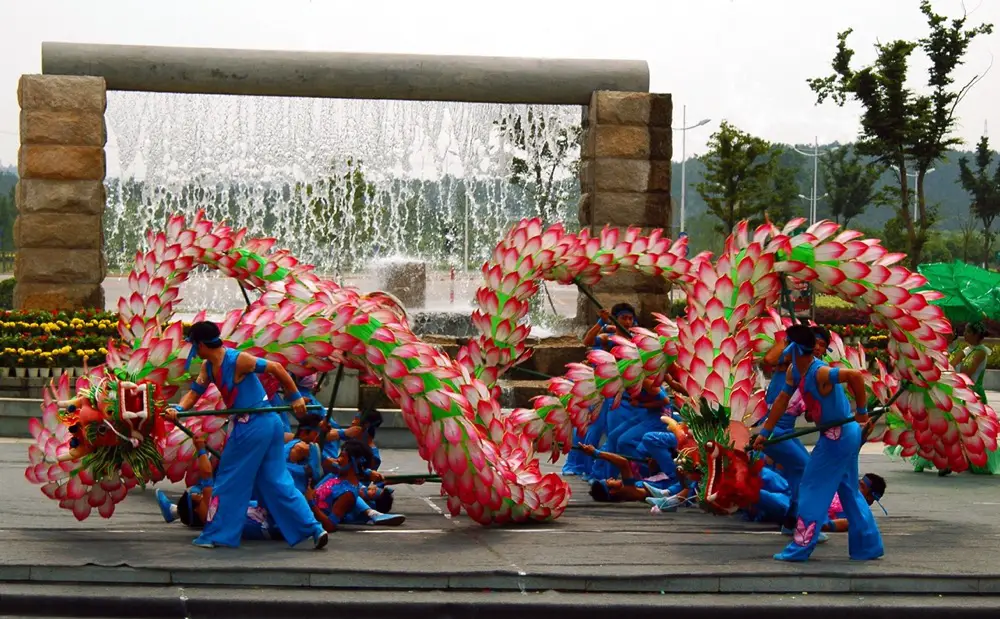
The Blinds Dragon Dance, popular in Zhejiang Province, is a unique and elaborate type of dragon dance. Dancers hold lotus lanterns, lotus leaf lanterns, and butterfly lanterns, and gracefully dance. Spectators see blooming lotus flowers swaying and dancing among the floating lotus leaves, resembling a beautiful butterfly flying through a flower garden. After a graceful and lyrical dance, the dancers gather together, and suddenly, a giant dragon emerges before the audience. The huge dragon head is depicted on the backside of an oversized tea flower lantern (or treasure basin). Each blooming lotus tightly interlocks, forming the dragon’s body, and the petals become the dragon’s scales. The beautiful butterfly becomes the swaying dragon tail, while the lotus leaves turn into layers of white clouds. The dancers, especially the girls, prefer immaculate lotus flowers and blend the elusive nature of the dragon, sometimes revealing themselves and other times hiding, with the dragon, appearing to sway along various objects, creating the Lotus Dragon Dance, adding a touch of charm to the majestic dragon.
Fire Dragon Burning Dance
Also known as the Fire Dragon Dance, this unique folk tradition is prevalent in the Fengshun area of Guangdong and is typically performed during the Spring Festival and the Lantern Festival.
The Fire Dragon Burning Dance has various folk legends associated with it. It is said that long ago, a fire dragon appeared in the Fengshun region, spewing fire and causing chaos. The land cracked, and crops withered, leaving the farmers desperate. In response, a young couple stepped forward, leading everyone to dig a mountain and channel water. However, the fire dragon returned and breathed fire, killing the young couple and drying up the water source. The couple’s son, Zhang Gong, inherited his parents’ ambition and went to Mount Emei to seek Taoist teachings. After three years, he returned and fought a fierce battle with the evil dragon for three days and nights, using divine fire to burn the dragon to death inside a cave. He, too, perished due to exhaustion. Since then, the region has experienced favorable weather and abundant harvests. To commemorate Zhang Gong and celebrate the harvest, the Fire Dragon Burning Dance is held every Lantern Festival night. Over the years, it has become a local tradition.
The “fire dragon” used in the dance is made of paper, around 15 to 20 meters long and divided into five sections. Colorful firecrackers are wrapped around the dragon’s body. Before the dance starts, the firecrackers are lit to signal the dragon’s arrival. Then, a team of shirtless dancers holding fire sticks runs rapidly around the area with the accompaniment of quick drumming and gongs, a segment called “inviting the dragon.” Next, the “fire dragon” appears, circling the performance area. First, it spouts fire from its mouth, and then the firecrackers attached to the dragon’s body are ignited, causing flames to shoot from head to tail, accompanied by thunderous bursts. The massive dragon dances amidst the encirclement of smoke and explosions, flipping up and down and swirling left and right, creating a captivating scene. At this point, pre-arranged fireworks are launched into the sky, with dazzling and colorful displays, pushing the Fire Dragon Burning Dance to its climax. The entire event lasts for more than ten minutes, ending with the extinction of the fire and the burning of the dragon. The performers’ arms and chests are covered with blisters, and the one with the most blisters is considered “lucky.”
Drunk Dragon Dance
The Drunk Dragon Dance, also known as “Jianlong” or “Zhuanlong,” is a traditional dance performed in the regions of Guangdong, Zhongshan, Zhuhai, and Macau in China. It is named “Drunk Dragon” because the dancers perform in a drunken and hazy manner. Historically, this dance was performed every year on the eighth day of the fourth lunar month to celebrate the birthday of Buddha Sakyamuni.
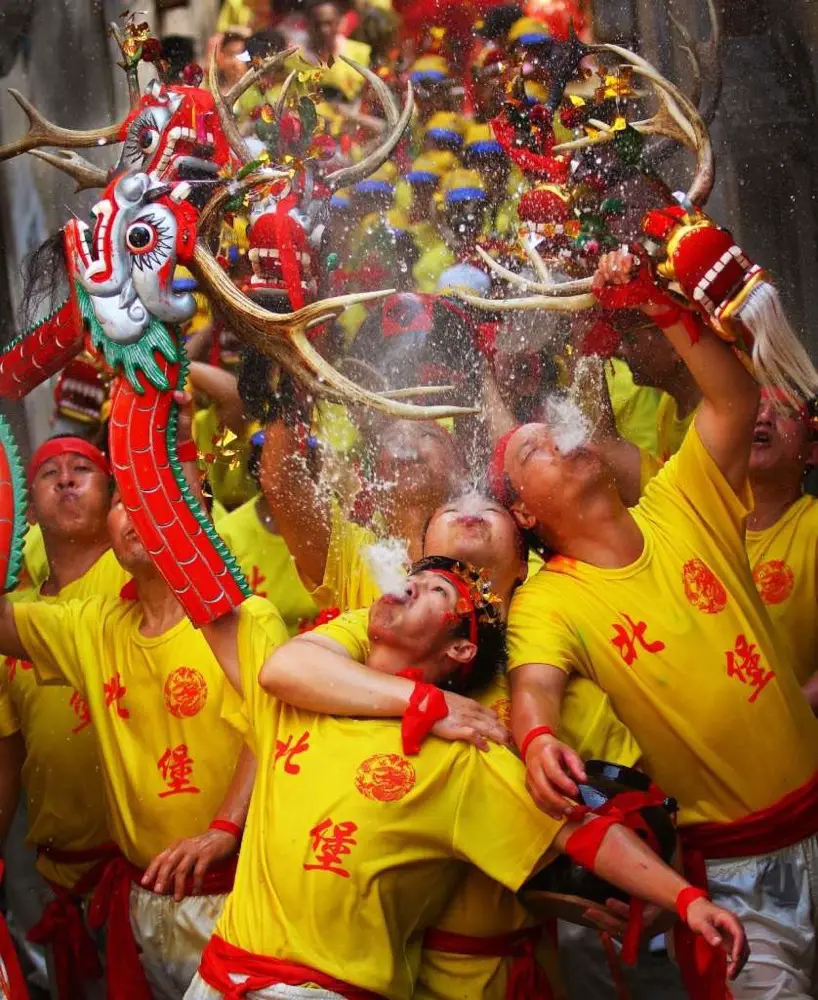
Water-splashing Dragon Dance
The Water-splashing Dragon Dance is a ritual performed by the Tujia ethnic group in the western part of Hunan province, China, to pray for rain during times of drought. During this elaborate ceremony, a dragon with one head and nine or eleven segments (representing the desire for abundant rain) is constructed using willow branches, without paper or cloth covering. Various aquatic creatures like fish, shrimp, clams, and mussels accompany the dragon.
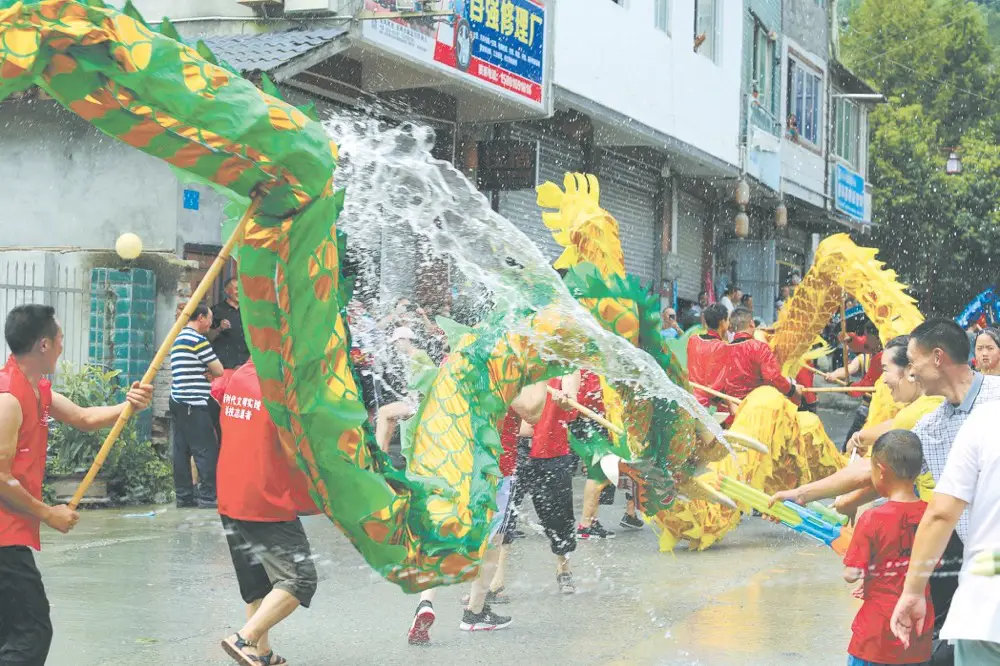
Lotus Dragon Dance
The Lotus Dragon Dance originated in the fourth year of Emperor Guangxu’s reign (1879) in China and is primarily performed in the area surrounding Niutan Town, southwest of Luxian County, Sichuan province. The dance has been successfully listed as part of the intangible cultural heritage of Luxian County. People perform the Dragon Dance during festivals to celebrate and pray for favorable weather and a bountiful harvest. The dance reflects the hard work and hopes of local farmers for a prosperous year.
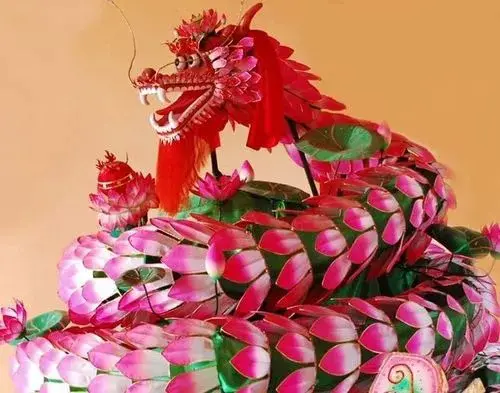
Banana Tree Dragon
As an intangible cultural heritage of Guangxi, the Banana Tree Dragon (also known as “Bajiao Long”) carries deep cultural significance from the Zhuang ethnic group’s rice cultivation traditions. The dance embodies the unique agricultural civilization of the Zhuang people and conveys their wish for abundant harvests and prosperity.
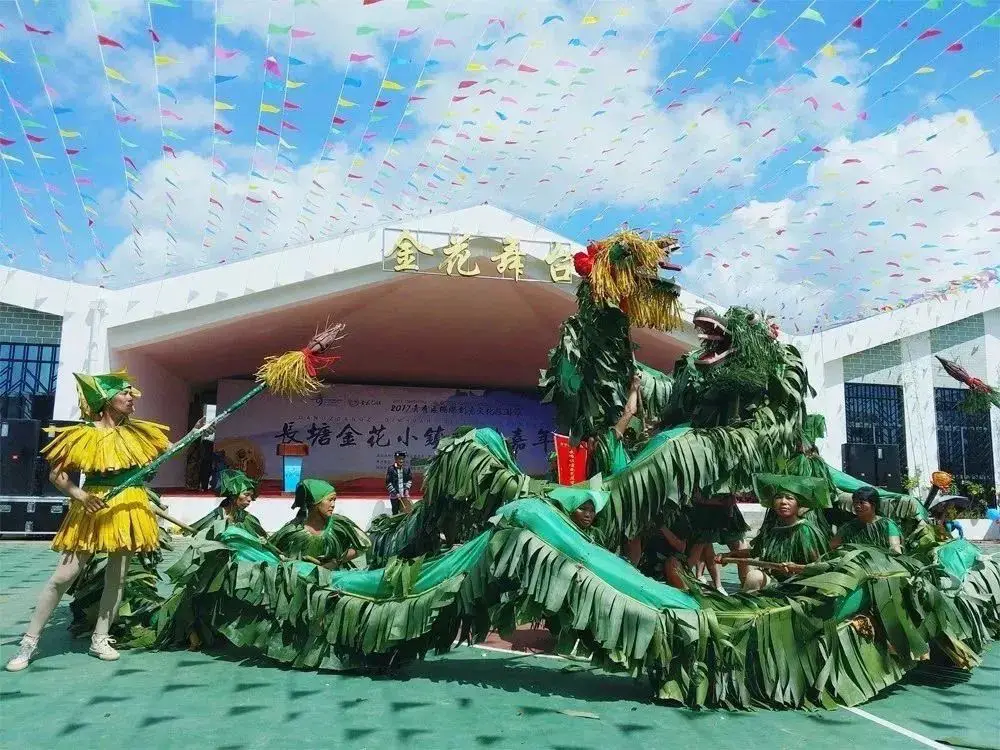
Water Dragon Dance
The Water Dragon Dance is a distinctive traditional performance in China that takes place on water bodies such as rivers, lakes, and seas. It is widely practiced across different regions, particularly in places like Huai’an (Jiangsu province), Yibin (Sichuan province), and Longhushan (Jiangxi province).

Bench Dragon
The “Bench Dragon” is one of the traditional folk activities originating from the Heluo region and is widely celebrated in various provinces and cities in southern China during the annual Lantern Festival. This custom, which has been practiced for several centuries, holds deep regional cultural significance in Fujian province, where it is used by locals to welcome deities and seek blessings. Villagers connect individual benches drilled with holes to form a long bench dragon, which can stretch over two hundred meters, creating a magnificent sight.
In 2008, the “Bench Dragon” from Datian County, Sanming City, Fujian Province, was listed as a nationally recommended intangible cultural heritage.
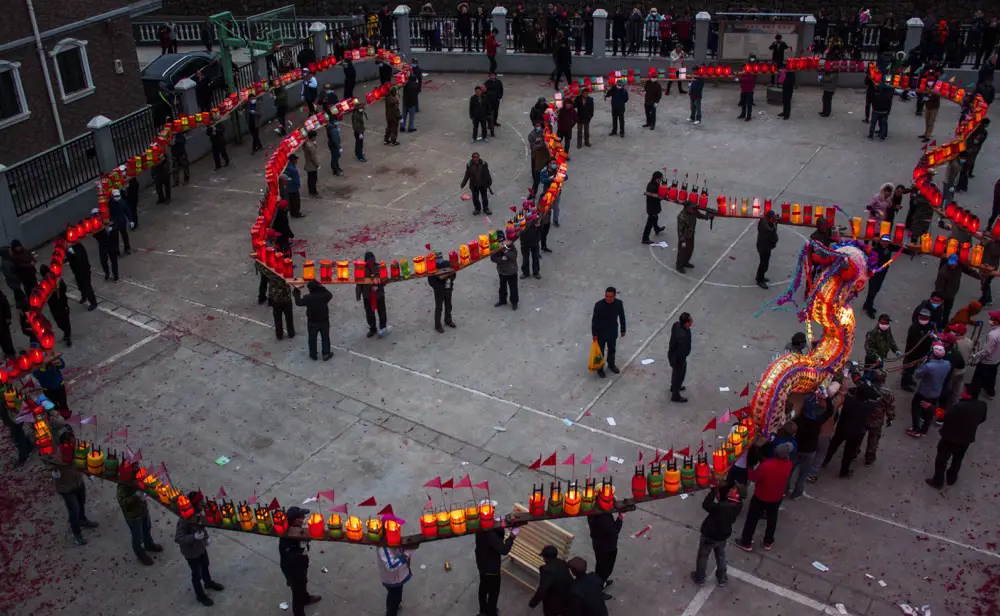
The Bench Dragon dance is said to have originated from religious activities of “dancing dragons to pray for rain” during the Han Dynasty. According to legend, during a severe drought, a water dragon from the East Sea leaped out of the water, causing heavy rainfall. However, the water dragon violated heavenly rules and was subsequently cut into pieces and scattered to the human world. People placed the dragon’s body on benches and connected them together, known as “Bench Dragon,” and tirelessly spread the news, hoping to bring it back to life. The custom of dancing the “Bench Dragon” emerged from this event. The dragon dance can be divided into “dry dragon” and “wet dragon,” with the former mostly for entertainment and the latter performed to pray for rain. When the dragon passes by, people enthusiastically splash water on it, and the performers become thoroughly soaked during the dance.
The Datian Bench Dragon is made by attaching transparent, exquisite plastic film to long benches, decorated with various colorful flowers. Two candleholders are placed inside, and both ends are drilled with circular holes about five centimeters in diameter. They are then connected by wooden sticks about 70 centimeters long and with the same diameter. The dragon parade goes around the village streets. This tradition has a history of over a thousand years and combines various art forms and craftsmanship, including painting, calligraphy, carving, as well as weaving, making, and pasting. It incorporates elements of sports, acrobatics, and dance.
When making the dragon head’s frame, a long wooden board is first roughly woven with bamboo strips to create the framework. Then, finer bamboo strips are used to add details. In the past, the bamboo strips were tied together with rough paper strings, but nowadays, fine iron wires are used for convenience.
After completing the frame, colored paper, transparent paper, plastic film, etc., are pasted on the outer layer. Once the outer layer is completed, dragon scales, patterns, and other decorations are cut from colored paper and pasted on the dragon’s body. This work is usually done by skilled and artistic women in the village. Finally, auspicious phrases such as “abundant harvest of grains” and “prosperity of livestock” are written with colored pens at the joints of the dragon. The making of the entire dragon head is then considered complete.
The Bench Dragon custom can also be found in other regions, such as Qingshui She Ethnic Township in Yong’an, Fujian; Gaoshan, Sanshan, and Shapu towns in Fuqing City, Fujian; Meixian Town in Youxi, Fujian; Zhanghu Town in Nanping, Fujian; and Shangrao in Jiangxi. It is also observed in various locations in Zhejiang, including Wucheng and Jindong districts in Jinhua; Dongyang; Pujiang; Wuyi; Yongkang; Yiwu; Lanxi; P’an-an; and Yongjia County in Wenzhou. Bench Dragon is also a tradition in other areas like Chongqing’s Baxian County, Chenzhou’s Guidong County, Shigang Town in Nanchang, and Huangcheng Town in Fengcheng City.
famous dragon dance
Nanlong (Southern Dragon)
As the name suggests, Nanlong is a type of dragon dance that originated in the southern regions of China. The dragon body in Nanlong is relatively heavy, with the dragon head being the heaviest part. The style of Nanlong is characterized by its grandeur and imposing presence. Due to its weight, the movements in Nanlong do not focus on intricate maneuvers like the Northern Dragon but instead emphasize physical strength.
Nanlong performances require a team of around ten people, with one person holding the dragon ball and the rest holding the dragon body. The dragon body is typically about nine meters long. As Nanlong doesn’t prioritize agility, the dragon can be as long as twenty meters, a hundred meters, or even a kilometer. The size of the dragon head varies depending on the length of the dragon body.
In terms of craftsmanship, Nanlong follows more traditional methods, with the dragon head made from woven bamboo paper. The traditional dragon body is adorned with patterns made from fabric. However, for competitive dragon dances, to achieve a lighter weight, the patterns are often painted directly on the fabric or even made using computer-assisted stitching.
Nanlong’s movements include coiling, S-bends, and the dragon head crossing over the dragon body, among others.
Yangdian Gaolong
Yangdian Town in Xiaogan, Hubei, is known as the “Hometown of Dragon Lanterns.” The dragon lantern in Yangdian, known as “Yangdian Gaolong,” has been listed as the second batch of intangible cultural heritage in Xiaogan City and the third batch in Hubei Province.
Every year, starting from the twelfth lunar month, people begin to construct the dragon lantern using bamboo pieces for the dragon body, tail, and embroidered dragon clothing. The dragon head and tail are made from colored paper and then connected to form a complete dragon lantern, usually consisting of twelve segments. The dragon body is composed of ten bamboo lanterns, with the dragon head and tail adding two more segments, symbolizing the twelve months of the year. On the twelfth day of the first lunar month, a dragon lantern opening ceremony is held, followed by parades and celebrations on the thirteenth day. Each dragon lantern travels through the narrow streets of Yangdian, and households set up incense tables to welcome the dragon. On the fourteenth day, the dragon lanterns visit the different neighborhoods to offer New Year’s greetings and blessings. On the fifteenth day, there are games and lantern displays. At midnight, the dragon lanterns are burned together with lively drumming and firecrackers, symbolizing the sending off of the lanterns to the heavens.
Yangdian Gaolong is made from bamboo, wood, cloth, and colored paper. The dragon clothing is typically in five colors: yellow, blue, white, red, and black, symbolizing the five elements of gold, wood, water, fire, and earth. The dragon lantern has a lit candle inside, and the dragon dancers manipulate it to simulate the movement of a real dragon. The performance includes various moves like exiting the cave, bowing in the four directions, diving into the hole, flipping over, and reflecting in the water. During slow movements, the dance is elegant and lyrical, while in fast movements, it becomes vigorous and bold, showcasing its unique local characteristics. The accompanying music is joyful and melodious, creating a strong artistic appeal.
Huangpi Dragon Dance
Huangpi Dragon Dance is a traditional folk activity unique to the Huangpi and Xiaogan regions of Hubei province. The term “Dragon Dance” here refers to a rural temple fair that combines various customs such as lion dance, dragon dance, colorful boat racing, bamboo horse racing, stilt walking, fish lanterns, and clamshell masks. Among these, the dragon dance, or “Wanlong” in the local dialect, is a significant event.
Huangpi has a long history of dragon dancing, and the local folk activities are rich and diverse, with a history of over a thousand years. The Dragon Dance, performed during the Lantern Festival, is one of the grandest folk customs in the Huangpi region. Each year, more than 200 police officers are dispatched to maintain order during the dragon dance activities in the villages and bays.
The Dragon Dance is an essential part of the Lantern Festival celebrations in the Huangpi area. Two people collaborate in the performance, with one person handling the dragon head and the other the dragon tail. The person controlling the dragon head uses martial arts movements, such as “Liujiu Fist” or “Shaolin Step,” while the dragon ball is maneuvered with movements akin to martial arts staff techniques. The two performers engage in coordinated movements, making the dragon appear lively and majestic. The dragon dance is accompanied by the rhythm of six gongs and drums, creating a festive and auspicious atmosphere. The dance incorporates various techniques and movements, such as enticing the dragon to dance, seizing the dragon ball, and circling around the pole. The dragon dances from left to right, wrapping around each pole, and after each wrapping, the dragon ball is playfully danced with. The Dragon Dance showcases a series of beautiful moves, including tempting the dragon with the ball, seizing the ball, performing with the ball, hiding the ball, searching for the ball, and wrapping around the pole. Throughout the performance, the dragon dancers skillfully mimic the motions of a dragon, displaying a vivid and lifelike spectacle.
Time: The Dragon Dance activities in the Huangpi region mainly take place over four days during the Lunar New Year period, from the 12th to the 16th day of the first lunar month.
Northern Dragon
The Northern Dragon is a style of dragon dance that developed in the northern regions of China. In terms of the dragon body, the Northern Dragon’s head is relatively small and light. It can be made using traditional paper-crafting techniques or newer methods using lightweight materials that allow for more intricate movements, such as somersaults. Unlike the Southern Dragon, the Northern Dragon’s movements are more diverse, requiring relatively less physical strength.
Northern Dragon performances are usually conducted in a dark environment, so the materials used in crafting the Northern Dragon are fluorescent. The Northern Dragon is popular not only in China but also in places like Hong Kong, Malaysia, Singapore, where dragon dance competitions and performances are regularly held.
Fujian Red Dragon Coiling Around the Pillar
The Red Dragon Coiling Around the Pillar originated in Miaofeng Village, which is known for its dragon lantern tradition. The red dragon in Miaofeng Village is made of locally aged bamboo (around 3 to 5 years old) as the framework, covered with high-quality red xuan paper or red silk fabric, creating a lifelike and vivid appearance in bright red color, symbolizing auspiciousness and prosperity during festive occasions. Therefore, it is called the “Red Dragon.” The most typical performance of this tradition is called “Red Dragon Coiling Around the Pillar.”
According to historical records in “The Folk Culture of Hakka Festivals in Liancheng,” the Red Dragon Coiling Around the Pillar was created by the Jiang family ancestors of the local area and has a history of over 300 years. At that time, the creators believed that Liancheng had the Rolling Dragon but lacked illuminated lanterns for dancing, while Gutian had lantern dragons but no dragon dances. To combine the strengths of both, they created the Red Dragon, a dragon that could dance and had illuminated lanterns. The dance incorporates martial arts steps, such as “Liujiu Fist” or “Shaolin Step,” for the dragon head and staff techniques for the dragon ball. The two dance moves are skillfully combined, forming a set of beautiful dance movements, including playing with the dragon ball, the dragon snatching the ball, playing games with the ball, hiding the ball, finding the ball, and coiling around the pillar. The performers manipulate the dragon to mimic a snake-like movement as it coils around the pillar. The movements are lively, majestic, and true to life.
In 2015, the Red Dragon Coiling Around the Pillar was listed in the Longyan City Intangible Cultural Heritage.
dragon dance costume
The “dragon” for the dragon dance is usually housed in the local Dragon King Temple. On the day of the dragon dance, with banners, gongs, and horns leading the way, the dragon body is brought out from the temple and connected to the dragon head and tail, followed by a ceremony to bring it to life. The dragon body is made of bamboo, crafted in a circular shape, with sections connected together, covered with a large red cloth painted with dragon scales. Every five to six feet, there is a person holding a pole, and the distance between the head and tail is about ten to several zhang (a traditional Chinese unit of length).
In front of the dragon, a person holds a pole with a large ball on top as a guide. During the dance, the ball swings back and forth, while the dragon head reaches out as if trying to catch the ball, creating a dynamic and lively performance. The dragon dance officially begins with the sound of firecrackers, and the dragon moves in circles or rolls as it progresses.
The dragon dance is a grand festival, and wherever it goes, it is warmly received. Dragon dance troupes may have five or six banquets in a day, known as “Dragon Exchange Banquets.” After the dragon dance is completed, the head and tail are burned, and the dragon body is returned to the temple.
Although the Lantern Festival originated in the early Han Dynasty and prospered during the Tang and Song Dynasties, the tradition of “dragon dance” is believed to have inherited the customs of “sacrificing to the heavens” from the Yin and Zhou dynasties. The dragon appears in historical records very early, and “dragon dance” originally had the meaning of “praying for a good harvest” as it implies “good weather and prosperous nation and people.”
Perhaps due to the dragon being regarded as the ruler of the ocean in mythology with immense power, and since the ocean represents water, the dragon naturally became associated with the deity of rainfall for crops. As food is essential to people’s lives, with grain being the foundation, controlling crops indirectly means controlling human life. According to this reasoning, the importance of the dragon even surpassed that of ancestors such as Emperor Shun, Qi, and Houji. Thus, the dragon, being considered an auspicious entity, appeared in celebrations and ceremonies, which is not surprising.
The “Liyue Zhi” (a classic on ceremonial rites) states: “The ancestral temple sacrifices, spring is called ‘key,’ summer is called ‘tie,’ autumn is called ‘chang,’ and winter is called ‘kao’.”
From this, we can understand that the “lighting of the lanterns” during the Spring Festival represents the “spring sacrifice.” Therefore, the dragon dance was initially a form of worship, not entertainment, and later became a part of celebratory entertainment likely during the Han and Tang dynasties.
what is the dragon in the dragon dance made of?
The dragon used in the dragon dance is typically made of a flexible and lightweight material to facilitate its movements during the dance. The specific materials used can vary based on regional traditions, local resources, and the skill of the artisans creating the dragon. However, some common materials used for making the dragon include:
Bamboo: Bamboo is commonly used to create the dragon’s frame. The long, sturdy, and flexible bamboo poles are used to construct the skeleton of the dragon, allowing it to move and twist gracefully during the dance.
Fabric or Cloth: Various types of fabric, such as silk, satin, or other colorful materials, are used to cover the bamboo frame and create the dragon’s body. The fabric is often painted or decorated with intricate patterns and designs to make the dragon look more vibrant and attractive.
Paper: In some traditional dragon dances, thin and lightweight paper, such as rice paper or colored craft paper, is used to cover the bamboo frame. The paper may be painted or printed with patterns, symbols, or the dragon’s features.
Paint and Decorations: Paint is applied to the fabric or paper to create the dragon’s scales, eyes, and other details. Additional decorations, such as tassels, ribbons, and sequins, may be added to enhance the dragon’s appearance.
Wickerwork: In some dragon dances, wickerwork or rattan may be used to add more intricate details to the dragon’s body and head.
Candle:Candles play an important role in Chinese dragon dance, particularly in traditional performances like the “Ban Deng Long” (板凳龙). Ban Deng Long is a traditional dragon dance commonly performed during the Chinese New Year celebrations. In this performance, the dragon’s body is illuminated by numerous candles, creating a mysterious and traditional atmosphere. The flickering light of the candles complements the dynamic movements of the dragon, making the entire performance more vivid and powerful. This not only allows the audience to experience the unique charm of Chinese traditional culture but also adds to the traditional ambiance of the dragon dance. As a result, candles play a crucial role in Chinese traditional dragon dance, becoming an essential part of Chinese culture.
LED Lights: In modern dragon dances, LED lights or small bulbs may be incorporated into the dragon’s body to create a dazzling visual display during nighttime performances.
The combination of these materials, along with the skillful craftsmanship of the makers, contributes to the dragon’s impressive and lifelike appearance during the dance. The dragon’s design and length can also vary depending on local customs and the specific purpose of the dragon dance performance.
how heavy is a dragon dance?
Traditional dragon dances generally require a team of 10 or more people. The dragon’s body is composed of many sections, stretching for tens of meters or even hundreds of meters, demanding significant strength and endurance from the performers.
The dragon’s head, the focal point of the performance, typically weighs at least 6 kilograms to carry the weight and grandeur of the entire dragon. The dragon’s body and tail are also made from various materials such as bamboo, silk, and colored paper, displaying exquisite craftsmanship and diverse patterns, adding both aesthetic and cultural value to the performance.
During the performance, the dragon dance team members need to possess excellent physical strength and skills to execute various challenging dragon dance movements. They must master different footwork, hand gestures, and body movements, while coordinating with the music and drum beats, showcasing the various forms and character of the dragon.
Dragon dance is not only a traditional folk art form but also a skill that requires long-term training and continuous innovation. The dancers’ dedication and innovation have led to the constant development and progress of dragon dance performance techniques, making a positive contribution to the inheritance and promotion of Chinese traditional culture.
ball dragon dance
The dragon pearl, also known as the dragon ball, is a significant component of dragon dance performances in traditional Chinese culture. It is usually represented by a colorful sphere or bead, symbolizing the essence of the dragon. As a core element of dragon dance performances, the dragon pearl has gained recognition and popularity alongside the spread of this traditional art form. Moreover, the color and design of the dragon pearl are meticulously chosen, as they represent different things and cultural symbols.
For instance, in architectural design, dragon pearls can be used as decorative elements to enhance the beauty and artistic sense of buildings. In textile design, dragon pearls are also widely utilized, symbolizing auspiciousness and happiness.
In summary, the dragon pearl holds great significance as an essential symbol in traditional Chinese culture, representing auspiciousness, prosperity, and happiness. In dragon dance performances, it is an indispensable core element. Furthermore, the dragon pearl is extensively applied in other fields, showcasing its unique historical and cultural value.
What instruments are in the Chinese dragon dance music?
Dragon dance is a traditional folk art form with cultural significance and value. In addition to requiring coordination among multiple performers, it also involves the use of various musical instruments. Among these instruments, drums play a crucial role as they provide a powerful beat that drives the rhythm and atmosphere of the entire performance. Typically, large drums, small drums, gongs, and woodblocks are used, and their rhythmic beats encourage the audience to dance along, making the performance more dynamic and impactful.
Aside from drums, gongs are also commonly used instruments. Made of bronze, gongs produce a strong and resonant sound that enhances the atmosphere and effect of the performance. In the show, gongs are often paired with drums to elevate the rhythm and grandeur of the entire spectacle.
Cymbals, made of bronze, produce both high and low tones, creating crisp and powerful sounds. In dragon dance performances, cymbals are used to reinforce the rhythm and mood, leaving the audience with a powerful emotional impact.
Apart from percussion instruments, flutes are also frequently used. With their clear and melodious tones, flutes add elegance and grace to the performance. In traditional dragon dance shows, flutes can also play various melodies and tunes, infusing the performance with cultural connotations and emotions.
Finally, the erhu, a traditional two-stringed bowed instrument, is commonly used. It produces soft and beautiful melodies that harmonize with other instruments in the dragon dance performance, creating a sense of tradition and artistic charm.
In summary, a wide variety of musical instruments are used in dragon dance performances, each with its unique sound and effect. The combination and use of these instruments add more colors and emotions to the dragon dance, allowing the audience to immerse themselves in the unique charm and cultural value of this traditional art form.
What Is the Dragon Dance for Chinese New Year?
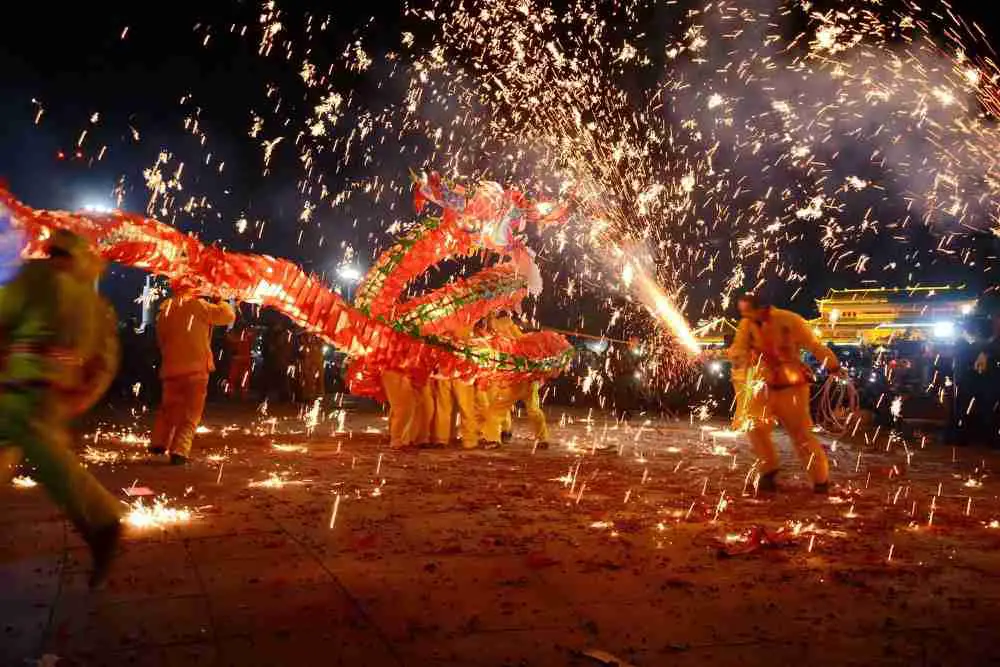
In Chinese, the dragon dance is known as long or longdeng. It is considered an important Chinese traditional dance and so is performed during many special occasions like weddings and birthdays as well as many of the Chinese festivals. Some of the festivals include Mid-Autumn Festival and the Lantern Festival. The most important festival where the dance is performed, however, is the Spring Festival, popularly known as the Chinese New Year or sometimes the Lunar Year.
The New Year dragon dance is a distinctive activity in Chinese traditional culture, symbolizing auspiciousness, prosperity, and happiness. In many parts of China, especially in rural areas and urban communities, people organize dragon dance teams to celebrate the New Year. The dragon dance troupe typically consists of strong and agile men dressed in traditional Chinese costumes, holding dragon poles. Accompanied by the sounds of gongs, drums, and firecrackers, they dance with lively steps, creating a warm and joyful atmosphere.
The symbolism of the dragon dance is rich and profound. Firstly, the dragon is a symbol in Chinese traditional culture, representing supernatural and divine power, and people perform the dragon dance to seek good luck and happiness. Secondly, the dragon also symbolizes unity and strength, inspiring people to come together and pursue happiness and success collectively. Additionally, the dragon dance signifies welcoming the arrival of spring, driving away coldness and gloom, and ushering in sunshine and vitality.
During the New Year period, dragon dance performances usually last for several days, attracting many spectators to watch and participate. The dragon dance troupe parades along streets and villages, showcasing the gigantic dragon’s movements, somersaults, and various skilled maneuvers, leaving the audience mesmerized. Spectators cheer for the dragon dance team and may throw red envelopes and candies as tokens of their blessings and joy.
In addition to the dragon dance, other traditional activities like lion dance and dragon boat racing are held to celebrate the New Year and strengthen community connections and unity. These activities not only enrich people’s spiritual lives but also carry on the essence of Chinese traditional culture.
In conclusion, the New Year dragon dance is an important activity in Chinese traditional culture, representing people’s aspirations and blessings, and symbolizing auspiciousness, prosperity, and happiness. Through the dragon dance performances, people can experience the charm of traditional culture and strengthen community connections, welcoming the arrival of the New Year together.
What Does The Dragon Dance Symbolize?
Dragons, according to Chinese mythology, are said to represent wisdom, strength, power, and good fortune. They are believed to be a source of good luck. As such dragons are considered among the four auspicious mythical creatures in Chinese mythology. The dragon dance is closely related to the tradition of worshiping dragons in China.
The Chinese New Year, on the other hand, is considered an important part of the Chinese calendar, where they usher in a new year. Because of this, all the traditions linked to this festival are meant to scare away evil and bring in good luck.
For this reason, performing the dragon dance during the Lunar Year is important as its seen as a way of dispelling all misfortune and inviting prosperity, luck, good health, and fortune with the new year. That is why you will always find performers holding up the dragon prop with poles and rhythmically moving it as per the steps of the dance.
History Of The Chinese Dragon Dance.
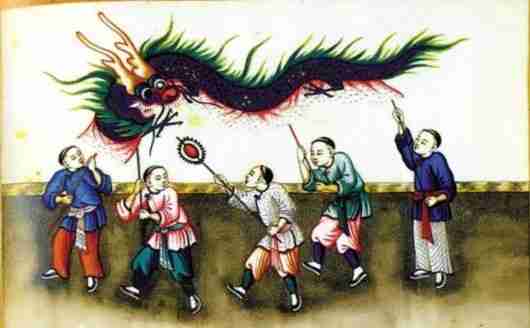
When Did The Dragon Dance Originated? Like dragons, the dance existed even in the early period of Chinese history. It dates back almost 2 thousand years, where it’s first referenced in the historical book about the Han dynasty, Hanshu. According to the ancient texts, the dance was initially called Chunqiu fan lu. It was a less elaborate form of the dragon dance that was performed in ceremonies like worshiping the ancestors or praying for the rain. The dance gradually evolved to what was known as yu long many an. It was performed as a form of entertaining foreign diplomats in the royal court.
The performance started with many dancers holding up a prop resembling an auspicious mythical beast called sheli zhi shou. The dance mimicked the actions of the creature before transforming into a giant flounder in a pond. From the flounder turned into a large 8ft dragon. This form of entertainment was carried on until the Song and Tang dynasty periods where the dance became a ceremonious activity in important festivals like the Chinese New Year.
By the 19th century, the dragon dance had reached Singapore. Just like in China, over time the dance grew to become an integral part of Singapore’s traditions. In Singapore, it’s performed during opening ceremonies and special events like the annual Chingay festival. Also, thanks to Chinese immigration, today the dragon dance has been spread all over the world where Chinese in foreign countries continue to practice it.
where did the Chinese dragon dance originate
Throughout the ages, the Chinese have celebrated their culture by performing the dragon dance. The young and old alike look forward to it every year at Chinese New Year and other celebrations.
Myth and legend surround the emergence of the Chinese dragon dance, but it is generally agreed that the dance originated during the Han Dynasty (206 BC – 220 AD). Some say the mythical creature known as the “Loong”—a potent symbol of strength, fortune, and prosperity—served as inspiration for the dragon dance. The Loong, a mythical creature held in high regard by the Chinese, was said to have the body of a snake, the horns of a deer, the scales of a fish, and the claws of an eagle.
The dragon dance began as a religious ritual only performed by priests, but it soon became a cultural tradition celebrated by people of all economic backgrounds. During the Tang Dynasty (618-907 AD), the dragon dance was thought to bring good fortune and prosperity to the community, and it became associated with Chinese New Year celebrations as a result.
These days, teams of dancers carry a long, winding dragon made of paper, silk, and bamboo to perform the dance. Drums, cymbals, and gongs provide the musical backdrop as the dancers weave the dragon through the streets. Many people believe that seeing the dance will bring them good fortune because the dragon represents power, strength, and luck.
dragon dance story
There is nothing more iconically Chinese than the dragon dance. This dance, which has become a staple of Chinese New Year and other celebrations, is said to have its roots in the Han Dynasty.
Legend has it that a terrifying dragon was the inspiration for the dragon dance. From the mountains, the dragon would swoop down and steal the villagers’ food and livestock, leaving them starving and destitute.
At some point, a wise old man showed up in town, and he explained to the citizens that they could drive the dragon away with enough noise and flashing lights. After hearing the old man’s recommendation, the villagers set about making a dragon out of paper, silk, and bamboo. They used vibrant colors and embellished the dragon with shiny coins and jewels.
The townsfolk then got together with some drummers and musicians and did a wild dance imitating the dragon’s stomping and snorting. The drummers beat out a rhythmic tempo, and the musicians played gongs, cymbals, and other instruments as the dragon dancers waved the dragon’s body up and down.
After witnessing the villager’s display of strength and bravery, the dragon fled the area and was never seen again. Since then, the dragon dance has represented success in the face of adversity, and it has been performed annually at Chinese New Year celebrations in the hopes of bringing good fortune and wealth to the community.
Even now, the dragon dance is a significant part of Chinese tradition and is widely celebrated around the world. All ages delight in watching the dance, which is believed to bring its audience members prosperity and good fortune.
why is the Chinese dragon dance important?
The dragon dance in China is a vital part of Chinese culture. This show has been a component of Chinese New Year celebrations and other festivals for millennia.
The dragon dance is significant because it is said to bring prosperity and good fortune to the neighborhood. Witnessing the dance is thought to bestow blessings and positive energies, as the dragon is a potent emblem of strength and good fortune. For many Chinese, witnessing the dragon dance is a way to bring good fortune to themselves, their families, and friends.
The dragon dance also holds great significance since it is a manifestation of Chinese national pride. There are certain cultural traditions and ideals that have been passed down from generation to generation, and this dance is a reflection of those. The Chinese people are able to honor their history and culture by performing the dragon dance for audiences around the world.
The dragon dance also represents togetherness and communal spirit. Groups of people working together harmoniously commonly do the dance, and the act of dancing together is meant to represent the value of teamwork and cooperation. The dragon dance is a way for the community to come together and honor their common culture and traditions.
Dragon dance holds significant importance in Chinese traditional culture for the following reasons:
Symbolic significance: The dragon is a symbol in Chinese culture, representing supernatural and divine power. Dragon dance expresses people’s aspirations and longing for happiness, auspiciousness, and good fortune. It also symbolizes unity and strength, inspiring people to come together and pursue happiness and success collectively.
Welcoming spring: Dragon dance also signifies welcoming the arrival of spring, driving away coldness and gloom, and bringing in sunshine and vitality. During the New Year period, dragon dance performances usually last for several days and become a prominent activity for celebrating the New Year.
Community bonding: Dragon dance activities are often organized by communities, and through these performances, people strengthen connections and unity within their communities. Dragon dance troupes parade along streets and villages, while spectators cheer for them and may throw red envelopes and candies as tokens of blessings and joy.
Preserving traditional culture: Dragon dance is an integral part of Chinese traditional culture, and its performances help in passing down and promoting this cultural heritage. Besides dragon dance, there are other traditional activities like lion dance and dragon boat racing, all aimed at celebrating the New Year and fostering community connections and unity.
In conclusion, dragon dance holds great significance in Chinese traditional culture. It not only symbolizes auspiciousness and prosperity but also welcomes spring, strengthens community bonds, and preserves Chinese traditional culture.
How To Do the Chinese Dragon Dance.
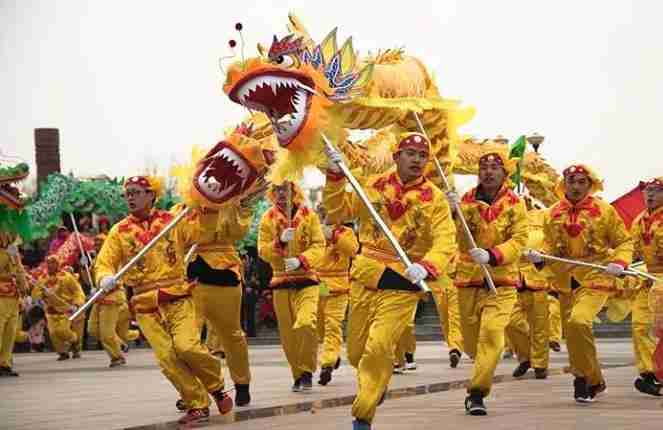
To perform the dragon dance, one first needs the two important props. The first prop is the dragon, which is its head and body. It can be made of various materials, including, paper, grass, cloth, and bamboo among others. The joints of the dragon are made in odd numbers because it is considered auspicious. So, you may find a dragon with 9 up to 23 joints or more, however, more than 15 joints are considered to be too heavy for the dragon dance performance. The other major prop is the longzhou, which means dragon pearl. It is the large ball that the dragon is meant to chase during the dance.
This dance can be grueling, which is why the dancers are required to train through martial arts to build up the strength that will allow them to carry the dragon throughout the entire performance. Typically, the dragon dance involves 20 basic steps that take the dancers at least half a year to fully master. Even then they have to practice for another one or two years before they can properly dance. That is because the coordination between the dance and the music from the dragon drums and gong are key to the perfect rhythmic movement of the dragon.
Most dragon dance performances last for half an hour which is broken down into 10 minutes intervals, so the dancers have a break to rest. The performance usually starts with a man holding the longzhou on a large pole in front of the dragon’s head. While moving in tune to the accompanying music, the lead dancer moves the pearl from side to side as the dragon follows behind, trying to catch it with no success. Throughout the dance, the pearl continues to tease the dragon, while the dragon shows off its antics chasing after it. In some performances, there is more than one dragon involved. Such performances make the dance more complicated but impressive. As the dragons chase after the eluding dragon pearl, they seem to intertwine but never get entangles together.
Over time the dragon dance has evolved into many forms including, grass dragon, dragon lantern, hemp dragon, dragon head, luminous dragon, lotus dragon, and bench dragon. There are, however, two main recognized styles of the dance that is the Southern and Northern dragon dance.
With the southern style, the focus is on strength and momentum, not flexibility. Because it does not involve, many agile movements, the dragon used in the dance is larger and heavier compared to the northern style dragon. The major moves of this style are circling and making S-shape with the dragon’s body by holding the dragon’s head above its body. The northern styles, on the other hand, focuses more on the flexibility and rhythmic movement of the dragon. As such, the dragon used is smaller than the southern dragon and made of significantly lighter material. The dragon is also made of fluorescent material and hence the dance is performed in the dark, so the dragon appears to be illuminating. This increased the appeal of the dance.
what does the dragon dance symbolize in Chinese culture?
Dragon lantern dance is a highly significant performance in traditional Chinese culture, representing the courage, resilience, and wisdom of the Chinese nation. The symbolism and significance of the dragon lantern dance are diverse and can be explained as follows:
Firstly, the dragon lantern symbolizes the dragon soaring through clouds, warding off evil spirits, and has long been associated with people’s wishes for favorable weather and national prosperity. In ancient times, dragons were believed to possess supernatural abilities, capable of controlling the weather and dispelling evil. Thus, performing the dragon lantern dance became a traditional cultural custom to pray for favorable weather and national prosperity.
Secondly, the word “dragon” in Chinese sounds like “prosperity” or “vast,” symbolizing business prosperity and abundant wealth. In Chinese culture, dragons are considered auspicious symbols, and the homophonic sound of “prosperity” is associated with the dragon. Therefore, the dragon lantern dance also symbolizes business prosperity and abundant wealth, representing economic prosperity and happiness in life.
Thirdly, the performance of the dragon lantern dance requires close cooperation among multiple individuals, symbolizing unity and collective effort. In the dragon lantern dance, a coordinated effort among several people is necessary to accomplish various challenging movements and performances. This spirit of close cooperation and unity represents another symbolic meaning of the dragon lantern dance.
Fourthly, the successful creation and dynamic performance of the dragon lantern imply the way to deal with life and work, emphasizing the importance of personal efforts and seizing opportunities. In the dragon lantern dance, the design and execution of the dragon’s form require meticulous planning and training to achieve a perfect outcome. This process signifies the path to success in life, which involves personal effort, timing, favorable conditions, and gathering the right people.
Lastly, in folk customs, dragon lantern dances are performed during festivals such as the Spring Festival, Lantern Festival, lantern fairs, temple fairs, and harvest seasons to celebrate abundant harvests and pray for peace. This traditional custom uses the dragon lantern dance to express longing and pursuit of happiness, peace, and good fortune, while also showcasing the unity, courage, and wisdom of the Chinese nation.
In conclusion, the dragon lantern dance is a highly important performance in traditional Chinese culture, symbolizing the courage, resilience, and wisdom of the Chinese nation. Through the above explanations and descriptions of the symbolism and significance of the dragon lantern dance, we can gain a deeper understanding and appreciation of this traditional cultural performance.
what do the dragon dance colors mean?
The different colors of the dragon dance symbolize the following meanings:
Red: Represents the sun and symbolizes hope and prosperity.
Blue/Green: Represents the sky and symbolizes favorable weather and harmony.
Green: Represents the earth and symbolizes growth and abundant harvests.
Purple: Represents luck and symbolizes the harmonious relationship between humans and nature.
Yellow/Gold: Represents power and wealth and symbolizes a prosperous and blissful life.
In summary, the various colors of the dragon dance carry different meanings and symbolic significance, making them an essential part of Chinese culture.
History Of Chinese dragon Dance
The dragon lantern dance is a highly significant traditional performance in Chinese culture, symbolizing the courage, resilience, and wisdom of the Chinese people. The dragon lantern’s meanings and symbolism are diverse, and the following are specific explanations and interpretations:
The origin of the dragon lantern dance can be traced back to the early Han Dynasty, but the tradition of “dancing the dragon” inherits the ancient custom of “offering sacrifices to heaven” from the Yin and Zhou Dynasties. In ancient times, dragons were considered divine creatures with supernatural abilities, capable of controlling the weather and dispelling evil. Therefore, the dragon lantern dance became a traditional cultural custom to pray for favorable weather and national prosperity.
Furthermore, the dragon lantern dance embodies the meaning of “favorable weather and national prosperity,” symbolizing the ancient practice of praying for a bountiful harvest. In mythology, the dragon is the master of the seas, possessing immense power, and as the master of water, it naturally became the god of rain for crops. As food is essential for the people, and grains sustain life, the dragon’s importance surpassed that of ancestors such as Emperor Shun, Qi, and Houji. Consequently, the dragon became revered as an auspicious symbol during celebratory rituals and festivals.
According to historical records in “Li Wang Zhi” (Records of Rituals and Ceremonies), the spring ceremony in the ancestral temple is called “Yue,” the summer ceremony is called “Tie,” the autumn ceremony is called “Chang,” and the winter ceremony is called “Kao.” Thus, the “lighting of lanterns” during the Spring Festival represents the “spring ceremony.” Therefore, the origin of “dancing the dragon” was originally associated with ritual worship, not entertainment, and the transition to celebratory entertainment likely occurred during the Han and Tang dynasties.
In conclusion, the dragon lantern dance holds great significance in Chinese traditional culture, symbolizing the courage, resilience, and wisdom of the Chinese people. Through the explanations and interpretations of the symbolism of the dragon lantern dance, we can better understand and appreciate the value and form of this traditional cultural performance.
origin of dragon dance
The dragon dance originated during the Han Dynasty and has thrived through the ages. Initially, it was a ritual to worship ancestors and pray for abundant rain, gradually evolving into a form of entertainment. By the Tang and Song Dynasties, the dragon dance had become a common performance during various festive occasions.
The dragon dance, also known as “shuǎ lóng dēng” or “lóng dēng wǔ,” is a unique Han Chinese folk entertainment activity. From the Chinese New Year to the Lantern Festival, dragon dances can be found in urban and rural areas across the country. According to legends, dragons have the power to control clouds and rain, dispel disasters, and symbolize auspiciousness. Therefore, the practice of performing dragon dances as a way to pray for peace and a bountiful harvest has become a customary tradition among the Han Chinese throughout the nation.
The origin of the dragon dance can be traced back to the Han Dynasty, and it has persisted through the generations without decline. Initially, it served as a ritual to worship ancestors and pray for abundant rain, gradually evolving into a form of entertainment. By the Tang and Song Dynasties, the dragon dance had become a common performance during various festive occasions. Dragons have been mentioned in historical records dating back to ancient times, and the dragon dance embodies the wish for favorable weather and national prosperity, having its roots in the tradition of praying for a bountiful harvest.
In conclusion, the dragon dance is a traditional and iconic Han Chinese folk activity, originating during the Han Dynasty and enduring through the ages. It began as a ritual to honor ancestors and pray for rain but gradually transformed into a form of entertainment. By the time of the Tang and Song Dynasties, the dragon dance had become a prevalent performance during various annual celebrations. The dragon dance symbolizes the wish for favorable weather, national prosperity, and a bountiful harvest, and it holds a deep cultural significance in Chinese tradition.
when did the dragon dance originated?
The dragon dance is a highly significant component of traditional Chinese culture, with a long history and rich cultural significance. As early as the Han Dynasty, the dragon dance existed as a ritual activity, which gradually evolved into a form of entertainment and became a common performance during various festive occasions. By the Tang Dynasty, the dragon dance had gained popularity and continued to spread widely, undergoing constant development and innovation. During the Ming and Qing Dynasties, the dragon dance reached its pinnacle, with various styles and schools of dragon dancing emerging, leaving behind a diverse cultural heritage for future generations.
The dragon dance is not merely a performance; it embodies a cultural spirit. In ancient times, the dragon dance symbolized the prayer for favorable weather, bountiful harvest, and the dispelling of disasters. People believed that through the dragon dance, they could communicate with the divine, expressing reverence and gratitude to their ancestors. Additionally, the dragon dance became an important activity for celebrating abundant harvests, welcoming the Spring Festival, and praying for reunions, making it an indispensable part of the traditional culture of the Chinese nation.
In conclusion, the dragon dance, as a vital component of traditional Chinese culture, carries a profound history and rich cultural significance. It serves as a means for people to express their beliefs, celebrate festivals, and carry on their cultural heritage. Even today, the dragon dance remains a beloved cultural activity, continually evolving and innovating, contributing significantly to the preservation and development of Chinese culture.
story of the dragon dance
There is a legend that also illustrates the commemorative and sacrificial aspect of the dragon dance. It is said that a long time ago, there was a village called Lotus Village by the Tiao Creek, with a lotus pond in front of the village, filled with blooming lotus flowers… One day, a small dragon emerged from the pond, startling the lotus. The dragon transformed into a flying dragon and soared into the sky, leaving the lotus calling out loudly, but the dragon had already disappeared without a trace. Since then, whenever a drought occurred along the Tiao Creek, the little dragon would come to disperse clouds and bring rain. In gratitude to the dragon, the local people collected forty-nine lotus flowers and used nine hundred and ninety-nine petals from the flowers to create a flower dragon. As it was just short of a thousand petals, the father was also called “Bai Ye” (meaning one thousand leaves), so they named it the “Bai Ye Dragon” (Hundred Leaves Dragon). Every year during the Spring Festival, the local people would play drums and gongs to perform the dragon dance.
why was the dragon dance created?
The dragon dance originated as a way to express people’s reverence and gratitude towards their ancestors. In ancient times, it was believed that the dragon dance could bridge the gap between humans and gods, allowing people to communicate their prayers and wishes to the divine. Therefore, during significant festivals or celebratory events, people perform the dragon dance to show their respect and gratitude to their ancestors, while also conveying their hopes for abundance, reunion, and peace. Additionally, the dragon dance reflects people’s worship of nature and their faith in the divine, making it a traditional cultural activity with profound cultural significance and historical value.
where did dragon dance originated?
The dragon dance originated in China. It is one of the most iconic and traditional forms of folk art in Chinese culture. The exact historical origins of the dragon dance are not entirely clear, but it is believed to have ancient roots that can be traced back thousands of years.
According to historical records and legends, the dragon dance may have originated during the Han Dynasty (around 200 B.C. to 200 A.D.) or even earlier. Initially, it was likely associated with religious and ceremonial activities, such as rituals to pray for rain and good harvests. Over time, the dragon dance evolved and became integrated into various cultural and festive celebrations.
The dragon holds a significant place in Chinese mythology and folklore, symbolizing power, strength, and good luck. As the dance spread and developed across different regions and dynasties in China, various styles and techniques emerged, each with its unique characteristics and cultural significance.
Today, the dragon dance remains an essential part of Chinese culture and is often performed during festivals like Chinese New Year, Lantern Festival, and other celebratory occasions to bring good fortune, ward off evil spirits, and celebrate unity and prosperity. The popularity of the dragon dance has also spread beyond China, being performed in many other countries with significant Chinese communities.
when is the dragon dance performed?
The dragon dance is a traditional and culturally significant performance in Chinese culture, typically held on the following occasions:
Chinese New Year: Starting from the first day of the first lunar month, dragon dances and lion dances are commonly performed to celebrate the Chinese New Year. People gather to watch the performances and enjoy the festive atmosphere.
Lantern Festival: On the fifteenth day of the first lunar month, which is the Lantern Festival, dragon dances and lion dances reach their peak. People visit to admire the lantern displays and watch the traditional dragon and lion dance performances, creating a lively and joyful atmosphere.
Dragon Raising its Head Day: On the second day of the second lunar month, known as the Dragon Raising its Head Day, it is considered an auspicious day for dragon dances. People perform the dragon dance to pray for favorable weather, good harvests, and blessings.
Duanwu Festival (Dragon Boat Festival): On the fifth day of the fifth lunar month, which marks the peak of Yang energy in the year, dragon dances are believed to ward off evil and express wishes for safety and good health.
In summary, the dragon dance is a vital part of Chinese traditional culture, with its long history and rich cultural significance. It serves as a way for people to express their beliefs, celebrate festivals, and preserve their cultural heritage.
what is a wedding dragon dance?
The dragon dance is an essential activity in Chinese traditional culture, often used to celebrate important festivals and joyous occasions like weddings. In the Chaoshan region, there is a tradition of performing the dragon dance during weddings. As the groom comes to greet the bride’s family, the dragon dance troupe holds floral baskets and dances joyfully to the rhythm of gongs, drums, and firecrackers, symbolizing bringing good luck and prosperity to the newlyweds and both families. The dragon dance is not only a traditional custom but also a way to express happiness and blessings. In the lively performance of the dragon dance, people can experience the profoundness of Chinese culture and the festive atmosphere. Besides the Chaoshan region, different regions in China have their unique forms and styles of dragon dance, all of which convey people’s aspirations and pursuit of a better life and family happiness.
Chinese dragon dance vs lion dance
Dragon dance and lion dance are two different traditional folk performance forms, and they have distinct differences in the following aspects:
Cultural background: Dragon dance originated from Chinese traditional culture, symbolizing auspiciousness, prosperity, and happiness. On the other hand, lion dance has its origins in Indian culture and gradually became part of Chinese traditional culture with the spread of Buddhism.
Appearance: Dragon dance usually involves a long dragon figure that requires many performers to manipulate. In contrast, lion dance features a lion-like figure with a shorter body, typically performed by two performers.
Movements: Dragon dance primarily consists of the giant dragon leaping, jumping, and coiling in the air, creating a lively and joyful atmosphere. In comparison, lion dance is more dynamic, with performers imitating various lion movements such as jumping, scratching, and showing affection, often interacting with the audience.
Costumes: Dragon dance performers typically wear colorful clothes, with a sash tied around the waist, and hold dragon dance poles. In contrast, lion dance performers usually wear lion head caps and colorful lion clothing while holding lion dance balls.
Regional differences: Dragon dance is performed all over the country, especially more popular in southern regions. Meanwhile, lion dance is mainly found in southern regions, particularly in Guangdong, Fujian, Zhejiang, and is especially prevalent in Hakka culture.
In conclusion, both dragon dance and lion dance are traditional folk performance forms with rich cultural heritage and regional characteristics. While they differ in cultural background, appearance, movements, costumes, and regional distribution, they are beloved traditional cultural activities widely passed down and cherished by the Chinese people.
Chinese dragon dance vs yang dance
Dragon dance and yangge are two different traditional folk performance forms, and they have some differences in cultural background, performance style, and movement style.
Dragon dance is a performance with distinct Chinese ethnic characteristics. It is usually performed by a group of performers holding props such as the dragon pearl, dragon body, and dragon tail. Dragon dance originated from traditional Chinese culture and symbolizes auspiciousness, prosperity, and happiness. During the performance, the performers need to coordinate with the rhythm of the music, making the dragon body dance with the music, creating a lively and joyful atmosphere.
Yangge is a performance form rooted in agricultural labor and also possesses Chinese ethnic characteristics. It is often combined with folk dance and music. The history of yangge can be traced back to ancient China’s agricultural culture period. It is a collective singing and dancing performance conducted by people to celebrate a bountiful harvest and express joy. During the yangge performance, performers usually hold colorful ribbons, gongs, and drums as props, dancing in sync with the rhythm of the music, presenting a lively and festive atmosphere.
Although dragon dance and yangge differ in performance style and movement style, both are beloved and widely inherited traditional cultural activities among the Chinese people. They embody rich cultural heritage and local characteristics. Whether it is dragon dance or yangge, they represent the diligence, wisdom, and joy of the Chinese people and are important cultural symbols and folk art forms.
Chinese dragon dance vs Dragon boat racing
Dragon dance and dragon boat racing are both traditional folk activities in China, and they have some differences in cultural background, form, and manner of participation.
Dragon dance is a performance with distinct Chinese ethnic characteristics. It is usually performed by a group of performers holding props such as the dragon pearl, dragon body, and dragon tail. Dragon dance originated from traditional Chinese culture and symbolizes auspiciousness, prosperity, and happiness. During the performance, the performers need to coordinate with the rhythm of the music, making the dragon body dance with the music, creating a lively and joyful atmosphere.
Dragon boat racing is a water sport and a traditional activity in the southern regions of China. It is usually held on rivers, lakes, or seas, where a group of participants paddle dragon boats in a race. Dragon boat racing originated from Chinese traditional culture and symbolizes unity, competition, and cooperation. During the dragon boat race, participants need to work together and coordinate to paddle the dragon boat as fast as possible to compete for victory.
Although dragon dance and dragon boat racing have differences in form and manner of participation, both are important components of Chinese traditional culture, embodying rich cultural heritage and local characteristics. Whether it is dragon dance or dragon boat racing, they represent the diligence, wisdom, and joy of the Chinese people and are significant cultural symbols and folk art forms.
Conclusion.
The dragon dance has become widespread across the world, with the Northern style being the most popularly performed. You can watch the performances anywhere from Singapore, Malaysia, and China towns across the world. Hong Kong, China, however, remains the uncontended dragon dance capital, where competitions and performances are often held.